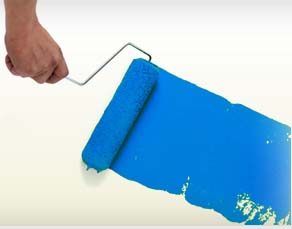|
|||||||
|
FAQ 1. How do I figure how much paint I'll need for
my project?
There are many factors that will determine the amount of paint that is used in a project, such as the type of surface being covered, the color of the existing surface, and the color of the chosen paint. A general rule is to calculate the square footage of the surfaces to be painted, and divide by the number of square feet that your selected paint indicates it can cover. For best results, take your measurements and paint information to your local paint retailer. 2. Does it really matter whether I buy the expensive paint or a less expensive one? When it comes to paint, you get what you pay for. More expensive paints have better quality ingredients, and this accounts for the difference in price. By using better ingredients (and higher priced paint), you will generally get better durability, flow, and overall quality. This will help to keep your paint in good condition for a longer time, which saves you time and money in the long run. 3. What is the difference between a water-based latex paint and an oil paint? Which should I use? Water-based paints are generally easier to clean up and to use, so they are generally preferred by do-it-yourselfers. High quality latex paints also have better adhesion and higher resistance to bleaching and fading. 4. What is the difference between a flat, high gloss, satin, and eggshell finish? These terms indicate the sheen or gloss level, or degree or light reflectance, of the paint. Basically, these are terms that are used to describe paint’s shininess. Semi-gloss Where to use: Kitchen and bathroom walls, hallways, children's rooms, playrooms, doors, woodwork and trim. Comments: More stain-resistant and easier to clean than flat paints. Better than flat for high-traffic areas. Satin (Range overlapping eggshell and semi-gloss) Where to use: Similar characteristics to semi-gloss and eggshell. Comments: Similar characteristics to semi-gloss and eggshell. Eggshell Where to use: Can be used in place of flat paints on wall surfaces especially in halls, bathrooms and playrooms. Can be used in place of semi-gloss paints on trim for a less shiny appearance. Comments: It resists stains better than flat paint and gives a more lustrous appearance. Flat What to use: For general use on walls and ceilings. Hides surface imperfections. Comments: Stain removal can be difficult. Use for uniform, non-reflecting appearance. Best suited for low-traffic areas. Matte Same characteristics as flat. 5. Can I repair a tear in my wallpaper without hanging a whole new strip? Yes! Simply place a larger piece of pasted wallcovering over the tear so that it makes an exact match with the wallcovering on the wall. Use a razor knife to double-cut through both layers around the tear. Remove the layers and then clean the exposed wall area. Repaste the new outer piece into the area. Note: an irregular, wavy cut following the design in the wallcovering will make your cut less noticeable. 6. Is lead paint really a concern for me and my family? Yes! Until 1978, lead paint was commonly used in paint on the interiors and exteriors of homes. Today, the US Department of Housing and Urban Development (HUD) estimates that about 38 million homes in the US still contain some lead paint. When the paint begins to deteriorate it can contaminate a household and cause lead poisoning. Even if the paint in your home is in good condition, remodeling and renovation activities can break down paint and cause the lead to emerge. When working with lead-painted surfaces, it is important to contain any debris and clean thoroughly. People working in those areas should also take precautions to protect themselves from contacting the paint. Personal belongings including furniture should also be protected when working with lead paint. Always make remodelers and painters aware if you know your home has lead paint. |



